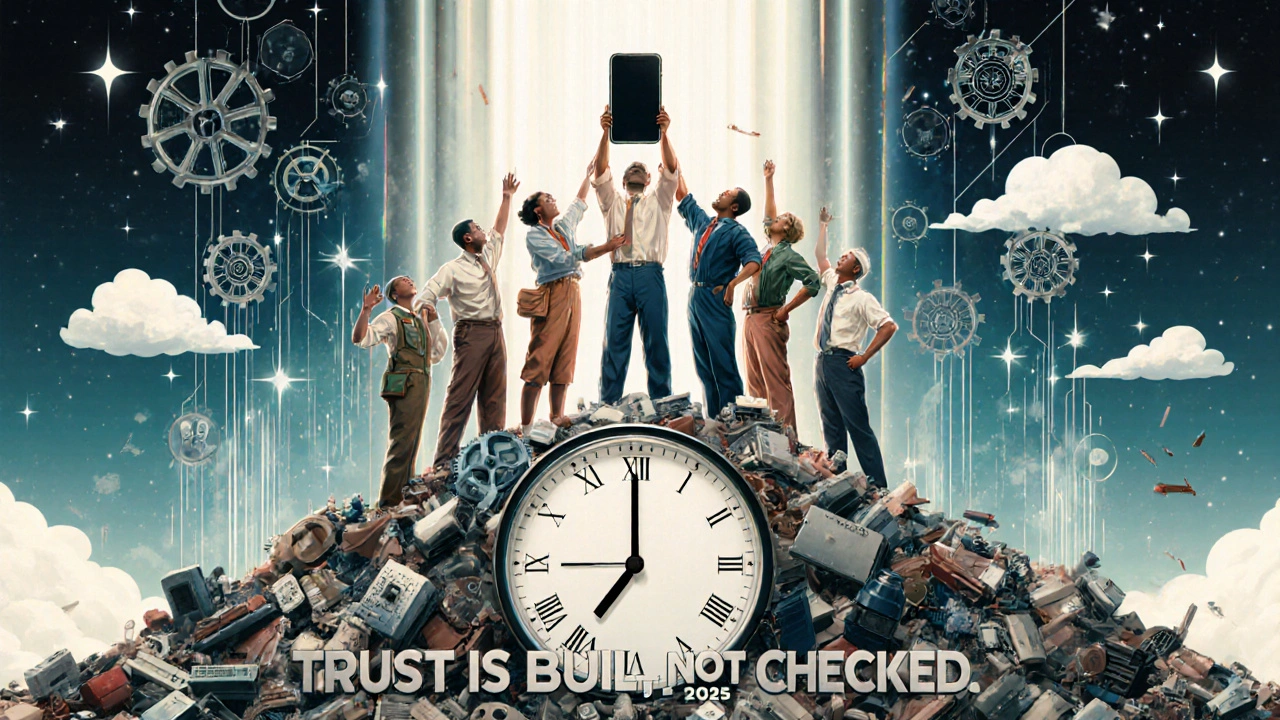When you buy a new car, a medical device, or even a smartphone, you expect it to work-perfectly, every time. But behind that expectation is a quiet, growing panic in factories across the U.S. Quality assurance isn’t just about catching defective parts anymore. It’s become the line between survival and collapse for manufacturers. And right now, that line is fraying.
The Real Cost of a Single Mistake
In 2025, a single missed defect isn’t just a recall. It’s a domino effect. One faulty battery in an electric vehicle can shut down an entire assembly line. One misaligned sensor in a ventilator can cost a life. And the financial hit? It’s not just the cost of replacing the part-it’s the lost production time, the damaged reputation, the legal fallout. According to the ZEISS U.S. Manufacturing Insights Report 2025, 38% of manufacturers say the cost of rework and iterations is one of their biggest headaches. That’s not just waste-it’s money evaporating. One medical device maker saved $1.2 million a year just by tightening measurement precision. Another electronics company spent $2.3 million on automated inspection systems… and saw error rates go up 40% because no one knew how to use them.Why Quality Isn’t Just a Department Anymore
Ten years ago, quality assurance was tucked away in a corner of the factory, checking parts after they were made. Today, it’s in the boardroom. Ninety-five percent of manufacturing executives say quality is mission-critical-not a cost center, but a growth engine. Why? Because customers won’t tolerate mistakes anymore. And competitors aren’t waiting. Manufacturers who use integrated quality systems-where data flows from design to delivery-see 22% lower rework costs and 18% faster time-to-market. Those still using paper checklists and manual inspections? They’re paying 43% more in labor just to catch the same errors.The Skills Gap Nobody Wants to Talk About
Here’s the ugly truth: factories are full of machines that can see micron-level flaws… but no one knows how to run them. Forty-seven percent of manufacturers say the biggest obstacle to better quality is a lack of skilled personnel. It’s not that workers are lazy. It’s that the job changed overnight. Today’s quality engineer needs to understand CAD models, interpret AI-generated defect patterns, and speak IT language-all while training new hires who’ve never held a caliper. Reddit’s r/Manufacturing community had over 247 comments in July 2025. The top complaint? “Inconsistent quality data between departments.” The second? “We can’t find people who know both old-school inspection and new digital tools.” A quality engineer at a Detroit auto supplier put it bluntly: “We’re expected to maintain aerospace-grade precision while moving at consumer electronics speed. Without the right tech and training? It’s impossible.”
The Tech That’s Working-And the Tech That’s Just Noise
Manufacturers are throwing money at shiny new tools. Sixty-six percent plan to use more than one metrology technology in 2025-3D scanners, AI-powered vision systems, real-time sensors. And it’s paying off for some. One company cut inspection time by 52% and improved accuracy by 34% using AI-driven monitoring. Another reduced false positives by 29% and saw defect detection jump 37%. The system paid for itself in eight months. But here’s the catch: 54% of users on Capterra say their new quality systems took longer to integrate than promised. Why? Because they bought the tech without changing the process. Or the people. As Robert Jenkins, CEO of Midwest Manufacturing Consortium, said: “Companies are throwing money at shiny new technologies without addressing fundamental workforce training needs.”Cloud, AI, and the New Rules of Quality
The future of quality assurance isn’t in a single machine. It’s in the network. Cloud-based Quality Management Systems (QMS) are now the standard. In 2025, 68% of new enterprise deployments use them-up from 52% in 2023. Why? Because they let a factory in Ohio and a supplier in Mexico share the same quality rules, the same data, the same alerts. AI isn’t just spotting defects. It’s predicting them. Early adopters report 27% fewer quality deviations reaching customers. Forrester warns: manufacturers who delay AI adoption will see 23% higher defect rates by 2027. And it’s not just about the product. QualityZe predicts that by 2026, quality metrics will be tied directly to customer feedback. If people complain about a button falling off a blender, the factory needs to know-fast-and fix it before the next batch rolls out.
Who’s Falling Behind-and Why
The divide is widening. Aerospace and medical manufacturers, where mistakes are life-or-death, have adoption rates above 70%. General manufacturing? Only 48%. Why? Cost. Complexity. And complacency. Smaller factories can’t afford $500,000 metrology systems. They also don’t have IT teams to integrate them. But the real problem? They think quality is someone else’s job. It’s not. It’s everyone’s job. And now, with trade uncertainty at 75% of manufacturers’ top concerns, and material costs rising, there’s zero room for error. A single shipment delay can idle machines for days. A single batch of bad parts can break a contract.What Works-Right Now
If you’re a manufacturer drowning in quality fears, here’s what actually helps:- Start small. Pick one high-value product line. Automate inspection there first.
- Train your team before you buy tech. A $100,000 camera is useless if no one knows how to interpret its data.
- Break down silos. Bring quality, production, and IT into the same room from day one.
- Use cloud-based QMS. It’s cheaper, faster to deploy, and scales with your growth.
- Measure what matters. Track rework costs, inspection time, and customer complaints-not just pass/fail rates.

Man, I’ve seen this play out in my shop-same story. We started with one automated vision system on our motor assembly line, and it cut our rework by 40% in three months. No magic, just consistency. The team hated it at first, but now they ask for updates before the boss does.
You’re all just ignoring the real problem: PEOPLE. Not tech. Not software. PEOPLE. Who’s training them? Who’s holding them accountable? Who’s even CARES? It’s a mess. A total mess.
Let’s not romanticize this. 68% adoption of cloud QMS? That’s a marketing stat. Real data shows 41% of those implementations had zero user adoption after 6 months. You can’t just slap on a dashboard and call it ‘digital transformation.’ It’s theater. And it’s expensive theater.
And don’t get me started on AI predicting defects-unless you’ve got clean, labeled data from 10,000 past failures, you’re just training a fancy guesser. Spoiler: most shops don’t even have that.
Guys, I get it. It’s scary. But here’s the thing-we’re not failing because we’re lazy. We’re failing because we’re stuck in the past. I work with a small shop in Ohio. They didn’t buy a $500K scanner. They bought a $300 tablet, loaded it with a simple app, and started taking photos of every defect with a timestamp and a note. Then they shared it on a Slack channel. Six weeks later, defects dropped 35%. No AI. No IT team. Just communication.
Start small. Start simple. Start NOW. You don’t need perfection. You need momentum.
I’m so tired of hearing about ‘tech solutions’… when no one even knows how to read a micrometer anymore… I mean, seriously… I watched a 22-year-old try to calibrate a dial indicator and he just… stared at it… like it was a spaceship… and then he asked if it was Bluetooth-enabled…
It’s heartbreaking. And I just… I can’t…
As someone who’s worked in factories in Mexico, Vietnam, and now here in Ohio-I can tell you, the real difference isn’t the tech. It’s the respect. In places where workers are treated like humans, not machines, quality is better. Always. Training isn’t just about skills-it’s about trust. If you don’t trust your team to speak up when something’s wrong, no AI will save you.
Focus on metrics that matter. Rework cost. Time to detect. Customer complaints. Not pass/fail rates. Those are vanity numbers. If you track the right things, you’ll see where the real leaks are. And you’ll know where to invest-not just in tech, but in people. One team meeting a week, with data on the screen, and everyone speaking. That’s the foundation.
wait hold on so you're saying we need to train people but also buy expensive tech but also break down silos and use cloud qms but also start small??
so... which one??
i'm confused now
also i think the word 'culture' was used 7 times in this post and i'm not sure if that's a good thing or if it's just marketing fluff
I’ve seen this in the UK too. The small shops that survive are the ones where the owner still walks the floor every morning. They know the names of the inspectors. They ask, ‘What’s blocking you?’ Not ‘Why did you miss this?’ It’s not about systems-it’s about presence. Tech helps, but it doesn’t replace listening.
Look, I’ve been in this game for 27 years. I’ve seen quality departments go from paper checklists to AI-driven predictive analytics. And let me tell you-the ones who succeed aren’t the ones with the fanciest equipment. They’re the ones who built a culture where the person on the line feels safe saying, ‘This part’s off.’ That’s it. That’s the whole thing. No software needed. Just psychological safety. And if your leadership doesn’t get that, no amount of cloud QMS or AI will fix your broken trust. You can automate inspection, but you can’t automate courage. And without courage? You’re just collecting data on your own failure.
One might argue that the rise in manufacturing quality anxiety is not a symptom of technological inadequacy, but rather an existential crisis of industrial modernity. The factory, once a site of human craftsmanship, has become a site of algorithmic surveillance. The worker, once a steward of quality through tacit knowledge, is now a data point in a feedback loop. The machine does not care if the part is good-it only knows if it conforms. And in that conformance, we have lost the very essence of quality: intention. The human hand, the trained eye, the quiet pride in a job well done-these are not measurable. And so, they are erased.
Just a quick tip from the field: if you're rolling out a new vision system, don't just hand it to the QA team. Bring in the machine operators first. Let them see the images, let them label the defects themselves. When they help build the AI’s ‘brain,’ they own the results. I did this at my last job-gave the line techs a tablet and asked them to tag 500 images of bad welds. Three weeks later, the AI was better than the lead inspector. And the team? They started catching things the system missed. Because now they understood it. That’s the secret: involvement, not imposition.